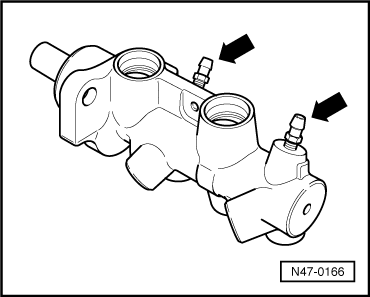| Bleed brake system, vehicles with or without ABS or ABS/EDL Mark 20 and Mark 60 |
| Special tools and workshop equipment required |
| t
| Brake filling and bleeding device, e.g. -VAS 5234- |
| t
| Brake pedal load, e.g. -V.A.G 1238/B- |
| t
| Vehicle system tester -V.A.G 1552- (only for vehicles with ABS/EDL) |

Note | t
| Only use new brake fluid complying with the standard → Chapter. |
| t
| If the system is opened, avoid working with compressed air and avoid moving the vehicle. |
| t
| Bleeding the brake system is described using the brake filling and bleeding device, e.g. -VAS 5234-. |
| If one chamber of the brake fluid reservoir has run completely dry, e.g. leakage in the brake system, bleeding must be carried out using the brake filling and bleeding device, e.g. -VAS 5234-. Then the hydraulic unit is tested with the vehicle system tester -V.A.G 1552- in the function "basic setting" or with the vehicle diagnosis, measurement and information system -VAS 505x-. |

Note 
WARNING | t
| Brake fluid is hygroscopic, i.e. it retains humidity from the ambient air, and must therefore always be stored in airtight containers. |
| t
| Brake fluid must never come into contact with fluids containing mineral oils (oil, petrol, cleaning agent). Mineral oils damage the plugs and boots of the brake system. |
| t
| Drained (used) brake fluid must never be used again. |
| t
| Observe the disposal instructions! |
| t
| Brake fluid is toxic, avoid skin contact. |
| t
| Because of its caustic effect brake fluid must not come into contact with paint. |
| t
| Rinse any brake fluid spills with a lot of water. |
| t
| Dispose of brake fluid in compliance with the applicable environmental regulations. |
|
| Vehicles without ABS or ABS/EDL |
| –
| Connect up the brake filling and bleeding device e.g. -VAS 5234- but do not yet switch it on. |
| –
| Remove dust caps from the vent valves of the brake calipers/wheel-brake cylinder. |
| –
| Switch on brake filling and bleeding device e.g. -VAS 5234-. |
| –
| Leave the bleeder screws on the plugged-on hose of the bleeder bottle open for as long as is takes until the bubble-free brake fluid flows out. |
| Vehicles with Mark 20 or Mark 60 |
| –
| Connect up the brake filling and bleeding device e.g. -VAS 5234- but do not yet switch it on. |
| –
| Insert brake pedal load. |
| If one chamber of the brake fluid reservoir has run completely dry (e.g. leakage in the brake system) first of all a pre-bleeding of the brake system must be performed. |
| Bleeding sequence for vehicles with Mark 20 → Chapter |
| Bleeding sequence for vehicles with Mark 60 → Chapter |
| Then bleed the hydraulic unit with the function „Basic setting“ and the vehicle system tester -V.A.G 1552-. |
| A characteristic feature of right-hand drive vehicles |
|
|
|
 Note
Note Note
Note
 Note
Note Note
Note